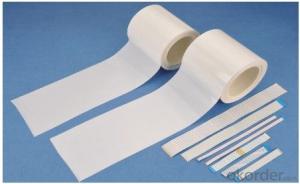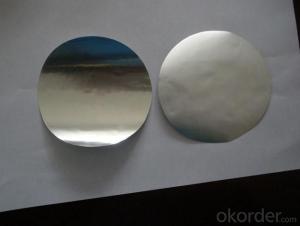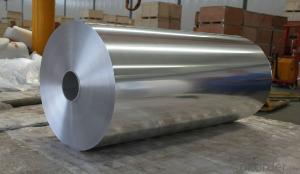Aluminum Foil Tape HAVC Solvent Insulation Self Adhesive Repair Roofing
- Loading Port:
- Shanghai
- Payment Terms:
- TT OR LC
- Min Order Qty:
- 5 m.t.
- Supply Capability:
- 9000 m.t./month
OKorder Service Pledge
OKorder Financial Service
You Might Also Like
Item specifice
High Quality HAVC Solvent Insulation Self Adhesive Repair Roofing Aluminum Foil Tape
Description
Aluminium tape is suitable for repairs on metallic surfaces such as car body work,
roof and gutter repairs and even insulating pipes. Suitable for applications indoors and outdoors,
it provides a general purpose temperature insulation and is also suitable for sealing of ducts, masking, protecting, repairing and closing.
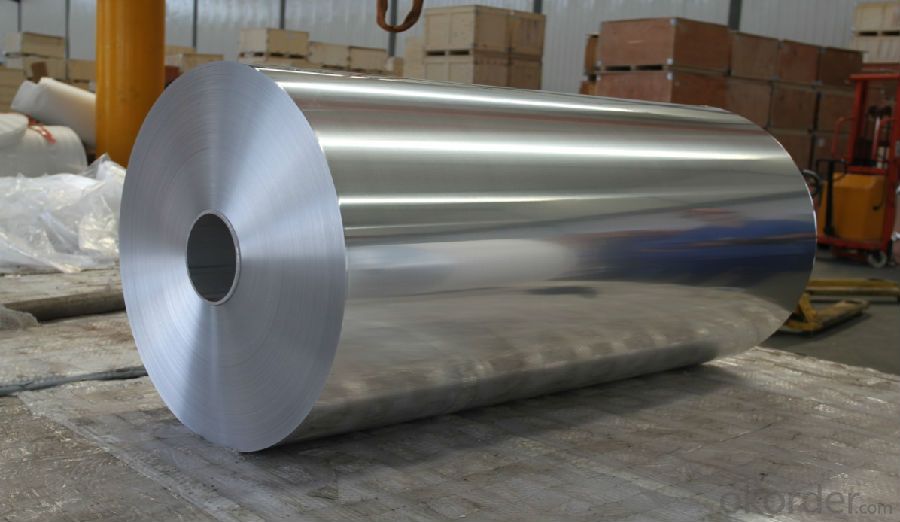
Technical Specification:
• Aluminum backing provides excellent reflection of both heat and light.
• High quality adhesive with strong adhesion and holding power offers permanent sealing and bonding on Foil-Scrim-Kraft Facing joints and seams in HVAC ductwork application.
• Good aging resistance both indoors and outdoors.
• Low moisture vapor transmission rate offers excellent sealing and patching performance
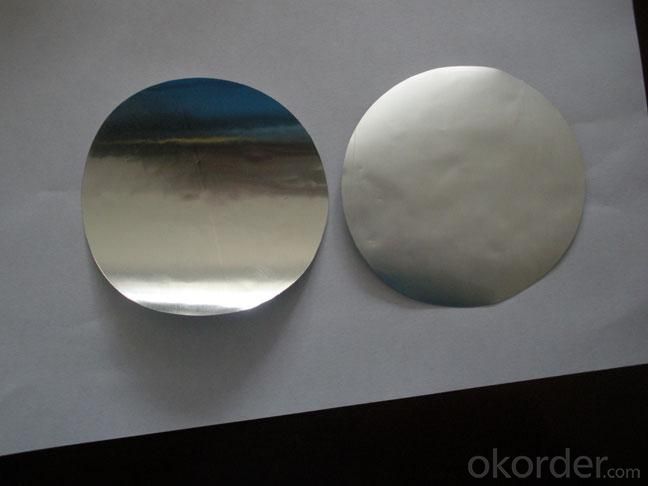
TYPICAL PHYSICAL PROPERTIES
PROPERTIES | METRIC | ENGLISH | TEST METHOD |
Backing Thickness | 50 Micron | 2.0 Mil | PSTC-133 / ASTM D 3652 |
Total Thickness | 90 Micron | 3.6 Mil | PSTC-133 / ASTM D 3652 |
Adhesion to Steel | 20 N/25mm | 72 Oz./In. | PSTC-101 / ASTM D 3330 |
Tack Rolling Ball | 15 cm | 6.0 In. | PSTC-6 / ASTM D 3121 |
Tensile Strength | 75 N/25mm | 17.0 Lb/In | PSTC-131 / ASTM D 3759 |
Elongation % | 3.5 | 3.5 | PSTC-131 / ASTM D 3759 |
Service Temperature | -30 ~ +120 °C | -22 ~ +248 °F | ------------ |
Applying Temperature | +10 ~ 40 °C | +50 ~ +105 °F | ------------ |
TYPICAL APPLICATIONS: HVAC industry for joining and sealing Foil-Scrim-Kraft Facing laminated fiberglass blanket / duct board joints and seams; joining and sealing flexible air duct seams and connections. General purpose holding, patching, sealing and masking applications – indoors and outdoors.
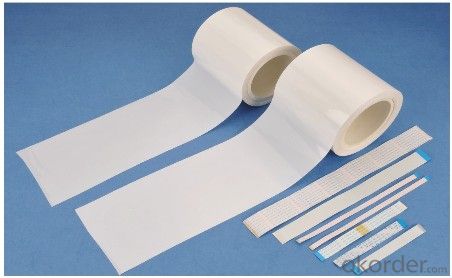
Aluminium tape FORM & SIZE AVAILABLE
Cut Roll: 48 / 50mm (2") / 60 / 63mm (2.5") / 72 / 75mm (3") / 96mm / 100mm (4").
Log Roll: 1200mm x 45 / 50m
Jumbo Roll: 1200mm x 1000m / 1200m
STORAGE & SHELF LIFE: 12 months when stored at 21°C (70°F) / 50% relative humidity out of direct sunlight.
SURFACE PREPARATION: It is essential, as with all pressure-sensitive tapes, that the surface to which the tape is applied must be clean, dry, and free of grease, oil or other contaminants.
PRODUCT USE: It is essential that the user evaluate the product to determine whether it is fit for a particular purpose and user’s method of application. Good results will be obtained when applied to a clean, dry surface with a suitable pressure on product between +10 ~ +40°C (+50 ~ +105 °F).
- Q:Can someone please explained what aluminum reacts slowly with dilute acided?Thank you!
- Firstly, dilute acids are weaker than concentrated acids. This slows the rate of reaction. Secondly, Aluminium is less reactive than the Group 1 and Group 2 metals, which slows the rate of reaction. It is less reactive because it has to form 3+ ions which is more draining than forming 1+ or 2+ ions. Thirdly, Aluminium oxidises well in air but, unlike rust, this oxide sticks to the pure aluminium, forming a protective layer.
- Q:Can the aluminum sheets be used for packaging applications?
- Packaging applications can indeed utilize aluminum sheets. As a versatile material, aluminum offers numerous advantages for packaging purposes. Its lightweight nature, coupled with its strength and durability, makes it perfect for safeguarding and maintaining a wide range of products, such as food, beverages, pharmaceuticals, and cosmetics. The malleability of aluminum sheets allows for easy customization, enabling tailored packaging solutions. Moreover, aluminum possesses exceptional barrier properties, effectively shielding packaged goods from moisture, oxygen, light, and other contaminants. Consequently, the shelf life of the products is prolonged. In addition, aluminum is an environmentally friendly choice for packaging applications due to its recyclability. Overall, the packaging industry extensively employs aluminum sheets due to their versatility, strength, durability, barrier properties, and recyclability.
- Q:Are there any health risks associated with using aluminum sheets?
- Yes, there are potential health risks associated with using aluminum sheets. Aluminum is a neurotoxic metal that can accumulate in the body over time. Prolonged exposure to high levels of aluminum has been linked to several health issues, including respiratory problems, bone disorders, and neurodegenerative diseases such as Alzheimer's. Additionally, certain studies suggest a possible link between aluminum exposure and an increased risk of developing breast cancer. It is important to take precautions when working with aluminum sheets and minimize exposure to the metal.
- Q:Hi, I'm new here. Yoroshigu.I'm trying to make flash paper for magic tricks.To do that I have to make flash powder but in my location I can hardly find ingredients. Not to think about buying. Usually, I wait for a season and buy firecrackers. Then, I take the power and soak them into the paper and dry. This works but not so flash. Burned more likely.So, I wonder if I take aluminium oxide from aluminium oxide sandpaper and mix with powder from firecracker would produce a brighter flash than firecracker power alone?anyone know please share.
- Aluminum oxide is a ceramic. Ceramics are already, in their lowest energy state and won't give you the effect you're looking for: The sand (that's all aluminum oxide is) that you're adding will make your flash dimmer (and dirtier). You want to get some aluminum metal powder. It is very reactive, and will make your flash appear much brighter. You're on your own as far as the safety of this.
- Q:what's the temperature tolerance of aluminum sheets?
- aluminum is a kind of silver white metal,melting point:660.4℃, boiling point: 2467℃,density: 2.70 g/cm?,very light, about 1/4 of iron's density.it has low hardness and good ductility, which makes it suitable for being pulled into threadlets or pressed into aluminum foils, and the later is usually used for packaging candy and cigarette. it has good electrical and temperature conductivity. it's used for the manufacture of electric wire and cable in electric power industry, and for the manufacture of cooker in daily life bined with the magnesium , copper,zinc,tin,manganese,chromium,zirconium,silicon and other elments,it can formulate various alloys that is broadly used for the manufacture of airplane,car,ship, materials of daily living equipment and the doors and windows of construction industry.aluminum is one of the best reflectors of heat and light, so it is used as thermal insulation material and the manufacture of reflecting mirror in the reflecting telescope.
- Q:What are the different forming methods for aluminum sheets?
- The different forming methods for aluminum sheets include rolling, stamping, deep drawing, bending, and stretch forming. Rolling involves passing the aluminum sheet through a series of rollers to reduce its thickness and increase its length. Stamping uses a die to shape the sheet by applying pressure. Deep drawing involves pulling the sheet into a die cavity to create a deep and complex shape. Bending is used to create curves and angles in the sheet by applying force. Stretch forming stretches the sheet over a die to create a contoured shape.
- Q:How are aluminum sheets manufactured?
- Aluminum sheets are manufactured through a process called rolling. The process starts with aluminum ingots, which are heated and then passed through a series of rolling mills. These mills apply pressure to the ingots, reducing their thickness and lengthening them at the same time. As the ingots pass through the mills, they are gradually transformed into thin sheets of aluminum. The rolling mills consist of a series of rollers, which are typically made of steel. The rollers rotate in opposite directions, and as the aluminum passes between them, it is squeezed and stretched. This continuous process of rolling helps to refine the aluminum's grain structure and improve its mechanical properties. To ensure the proper thickness and surface finish, the aluminum sheets may go through multiple passes in the rolling mills. Each pass gradually reduces the thickness of the sheet until the desired thickness is achieved. The final pass also imparts the desired surface finish. After the rolling process, the aluminum sheets may undergo further treatments such as annealing or surface treatments to enhance their properties or appearance. Annealing involves heating the sheets to a specific temperature and then cooling them slowly to relieve internal stresses and improve their strength. Once the sheets are manufactured and treated, they are typically cut into desired sizes and shapes. This can be done through shearing, which involves cutting the sheets with sharp blades, or by using specialized cutting machines. Overall, the manufacturing of aluminum sheets is a complex and precise process that involves heating, rolling, and treating the aluminum to achieve the desired thickness, finish, and properties.
- Q:some car manufactures use aluminium car body on a steel sub-frame. explain, using electrode potential what would happen if a weak acid was to become trapped in the space between these two metals!! any current plzz help, its for my assignment, and i dont understand
- Chemistry is all about how atoms exchange electrons. Some kinds like electrons better than others, and this is the basis of electrochemistry and Redox reactions. It all starts with the acid: HAcid - H(+) + Acid(-) The important thing is the H(+) ion, which is positive because it is a Hydrogen atom which has lost an electron. This leaves it with a positive charge, since it is nothing but a positive proton at this point. Fe + 2H(+) - Fe(+2) + H2 The above is a typical reaction between an acid and most metals. The H(+) ions strip an electron from the metal to form a metal ion and Hydrogen gas. What has happened is the Hydrogen ions have oxidized the Iron. The Iron in turn has reducted the Hydrogen. In terms of electrochemistry, there are two half reactions going on simutaneously. First, the Iron atoms generate two negative electrons: Fe - Fe(+2) + 2e(-) = OXIDATION OF IRON Then the Hydrogen ions combine with the electrons to form Hydrogen gas: 2H(+) + 2e(-) - H2 = REDUCTION OF HYDROGEN Note that in both reactions, the charges are equal on either side of the reaction. The next part of this process happens when the Iron ions come into contact with the Aluminum metal: 3Fe(+2) + 2Al - 2Al(+3) + 3Fe Note the Iron ions are recting exactly the same way the Hydrogen ions did. In other words, they are oxidizing the Aluminum. The Aluminum is now reducing the Iron. The net result of this is that the acid rusts the Iron and then the Iron rusts the Aluminum. The end result is the production of tiny amounts of Hydrogen gas, The Iron being displaced from where it had initially been, and the solid Aluminum discintegrating into some form of Aluminum salt. Calculations involve something called an electrochemical series and the voltage is given using the Nerst equation. Both the electrochemical table and the equation can be found in any chemistry textbook.
- Q:Can aluminum plate protect against radiation?
- First, the installation depends on the way, the direct aluminum plate can not, the aluminum plate must be grounded in order to play a role. The ground is connected with the earth plate, this shot to the electromagnetic wave on the aluminum plate will be aluminum absorption into electrical energy and flow to the ground, if not grounded on the other side will generate an electric field in aluminum, is directly through to the. In fact, grounding is very simple, if the installation of the use of metal screws directly contact the aluminum plate, but also with the cement wall contact, you can be grounded, although not good grounding. If the wall is a wooden board and so on, the insulating material can not, and then there is a screw, if it is used in the wall dug into the plastic sleeve also can not, because the plastic will be insulated.
- Q:Are aluminum sheets suitable for chemical processing equipment?
- Under certain conditions, chemical processing equipment can utilize aluminum sheets. Aluminum demonstrates good resistance to a variety of chemicals, including acids and alkalis. It exhibits exceptional resistance to corrosion in acidic surroundings like hydrochloric acid and sulfuric acid, as well as alkaline solutions such as sodium hydroxide. However, it is crucial to acknowledge that aluminum is not universally suitable for all chemical processes. It is not advisable to employ it in applications involving potent oxidizing agents like nitric acid or chromic acid, as these substances can swiftly corrode aluminum. In addition, aluminum is incompatible with certain organic solvents and can react with them, leading to equipment degradation or malfunction. In certain situations, aluminum can be employed in chemical processing equipment by employing protective coatings or linings to bolster its resistance against specific chemicals. This approach can enhance its longevity and broaden its range of applications. In conclusion, although aluminum sheets can be appropriate for chemical processing equipment in numerous cases, it is imperative to carefully evaluate the specific chemicals and operating conditions involved to ensure compatibility and steer clear of potential corrosion or malfunction issues.
1. Manufacturer Overview |
|
|---|---|
| Location | |
| Year Established | |
| Annual Output Value | |
| Main Markets | |
| Company Certifications | |
2. Manufacturer Certificates |
|
|---|---|
| a) Certification Name | |
| Range | |
| Reference | |
| Validity Period | |
3. Manufacturer Capability |
|
|---|---|
| a)Trade Capacity | |
| Nearest Port | |
| Export Percentage | |
| No.of Employees in Trade Department | |
| Language Spoken: | |
| b)Factory Information | |
| Factory Size: | |
| No. of Production Lines | |
| Contract Manufacturing | |
| Product Price Range | |
Send your message to us
Aluminum Foil Tape HAVC Solvent Insulation Self Adhesive Repair Roofing
- Loading Port:
- Shanghai
- Payment Terms:
- TT OR LC
- Min Order Qty:
- 5 m.t.
- Supply Capability:
- 9000 m.t./month
OKorder Service Pledge
OKorder Financial Service
Similar products
New products
Hot products
Related keywords
